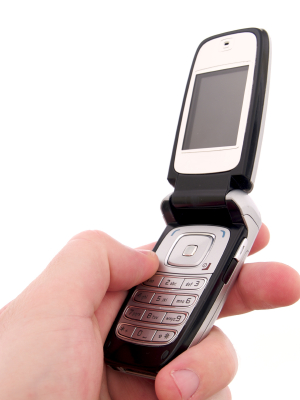WASHINGTON -- Americans punched out more than 110 billion text messages in December 2008, double the number in the last month of 2007, as the shorthand communication becomes a popular alternative to cell phone calls.
The nation's 270 million cell phone subscribers each sent out an average of 407 text messages in December 2008, according to government statistics released Tuesday by the Census Bureau. That's more than double the 188 messages sent by the average cell subscriber during the same period in 2007.
The figures did not break down the texting by age, but the overall numbers understate the thousands of texts sent each month by many teens -- balanced out by older folks who don't text as much.
"We are seeing a clear trend of huge increases in text messaging," said Amanda Lenhart, senior research specialist at the Pew Internet and American Life Project. "If teens are a leader for America, then we are moving to a text-based communication system. For them, there is less interest in talking."
ANH Comment
The news was flooded today with articles similar to the one above, driving home our increasing reliance on the mobile or cell phone. Alongside the increasing reliance on the cell phone, as compared with corded phones or face to face communication, comes the potential for increasing exposure to harmful electro-magnetic radiation (EMR).
What’s good about it?
The news that cell phone users are choosing to text rather than call is positive as it means that the phone is being used further away from their body. This reduces the amount of harmful radio frequency (RF) in the microwave range reaching the brain and therefore reduces long-term potential risks of developing tumours.
What’s bad about it?
However, the reliance on the mobile phone means people are being exposed to cell phones for longer and longer periods of the day. For many, cell phones are seen as essential accessories that are kept close to their person and left switched on, sometimes 24 hours a day.
How many of you sleep with your mobile phone on your bedside table, switched on over night? How many use your phone to listen to music with earphones? All of these actions mean that some people are exposing themselves to significant amounts of RF radiation all day, every day. For children, this can be a particular risk.
Where to find out more about the science
The Bioinitiative Report, published in 2007, gives the low-down on the risks that we are exposed to in our electronic age. This report states that “phone exposure has been linked in more than one dozen studies to increased risk for brain tumors and/or acoustic neuromas (a tumor in the brain on a nerve related to our hearing).” It also states “For brain tumors, people who have used a cell phone for 10 years or longer have a 20% increase in risk (when the cell phone is used on both sides of the head). For people who have used a cell phone for 10 years or longer predominantly on one side of the head, there is a 200% increased risk of a brain tumor.”
Kids, beware
Although adults have previously led in the cell phone ownership, several years of survey data collected by the Pew Internet & American Life Project show that those kids aged 12-17 are closing the gap. In its 2004 Teens and Parents project, the survey showed that 45% of teens had a cell phone. Since that time, cell phone use has climbed steadily among teens to 63% in the fall of 2006 to 71% in early 2008.
As mentioned, the findings of the Bioinitiative Report illustrate the positive side of people preferring to text as a means of communication. However, just having a phone near to us is exposure in itself so how are we to protect ourselves?
The Bioinitiative report found that even the smallest distance can make a difference to the amount of EMR exposure a person is exposed to. Below are some of ANH’s suggestions to protect yourself from electro-radiation (visit our campaign page – for more suggestions):
- Use corded telephones whenever possible instead of a cordless DECT phone (a DECT phone emits radiation equivalent to living within 250 metres of a cell phone mast!)
- Do not use belt holsters or pockets to carry your phone. Carry it as far from your body as possible (the outside pocket of your bag). This short distance can make a huge difference.
- Ensure you have at least one corded telephone in your house and workplace so that this can become your most often used telephone
- Do not use any cordless or mobile telephone for extended periods i.e., more than 10 minutes per use.
- Try to avoid placing mobile phones directly against the ear or head. If you need to do this, alternate the phone between each ear every minute or so.
- Use speakerphone or an air tube device if possible to avoid placing mobile phone against the head (close to the brain). Source air tubes.
- Do not place any wireless router or cordless telephone base station (DECT phone) in bedrooms or rooms occupied regularly
- If a cordless handset is required use one which does not emit EMR when not in use e.g., Orchid Low Radiation phones
- Turn off any wireless routers or cordless DECT base stations at night
- Avoid using wireless baby monitors (use hardwired systems instead)
To read more about Electro Magnetic Radiation, visit the ANH EMR campaign page








Comments
your voice counts
There are currently no comments on this post.
Your voice counts
We welcome your comments and are very interested in your point of view, but we ask that you keep them relevant to the article, that they be civil and without commercial links. All comments are moderated prior to being published. We reserve the right to edit or not publish comments that we consider abusive or offensive.
There is extra content here from a third party provider. You will be unable to see this content unless you agree to allow Content Cookies. Cookie Preferences